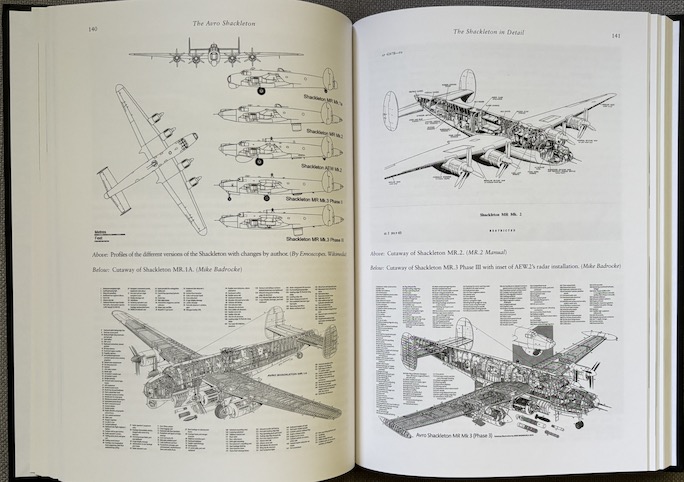The Avro Shackleton: The Long-Serving ‘Growler’
 by Jason Nicholas Moore
by Jason Nicholas Moore
“The Shackleton was already obsolescent in its basic configuration by the time of its first flight in 1949, stemming from its less than cutting edge design. It was not very maneuverable, and with the deafening roar of the sometimes maintenance-heavy engines, and the less than perfect comfort it provided its crew, it was by no means an outstanding aircraft. It was however a good aircraft and was a sturdy, durable, and commodious aeroplane that performed whatever task was asked of it.”
Ever heard of “Shackleton Ear”? Has nothing do with the British explorer or frostbite but is caused by that “deafening roar” of those twin contra-rotating props, especially the pitch of sound, that crews had to endure on flights as long as 15 hours.

Bottom right: a good view of the dual props (3 blades each x2 x4 =__).

And another shot, just because this is such an unusual arrangement.
Even casual observers know the Avro Lancaster but its latest iteration, the Shackleton, draws blank looks outside the aviation community. This is quite odd when you consider that it was in RAF service for 40 years, until 1991, and that one took to the air as recent as 2007. Also, there has been a steady flow of publications about it over the decades, including even a Haynes Workshop Manual (2015). The author has provided a fine Bibliography and is fully cognizant of all that has been written, which is why he is able to outfit his book with a long list of goodies not found elsewhere, making it the most comprehensive Shackleton book yet and thus a not to be missed addition to the library.
The intro quote is excerpted from early in the Preface. You can practically taste the tension between the various attributes, and by the time the book winds down the author is still moved to write: “Even after reading the previous pages, the reader may be forgiven for not knowing exactly what to make of the Shackleton.” A book that is able to deal constructively with such dichotomy is not easy to write and Moore is to be commended for an exemplary job. This is not his first rodeo (an especially apt expression as he is a native Texan) and one can only marvel that he is so good at a job that his professional career/s really did not directly prepare him for.
Structurally, everything in this book shows forethought: a Glossary and Timeline are in front where they cannot possibly be overlooked, and everything that is useful but secondary to the main text (cf. production numbers, aircraft histories, survivors, computer game appearances(!)) is corralled into 12 Appendices at the back, followed by a Bibliography and an Index.

The book is only 7 x 10″ so don’t expect to see a lot in these cutaways or even be able to decipher the legend.
That Glossary already makes a fine first impression because it not only contains the obvious aviation and military terms but entirely unexpected entries such as definitions for Apartheid, Colonial Policing, Cold War etc. This familiarizes the reader with the subject matter in a more direct way than merely listing multiple page references for them in the Index. In fact, quite a few of the big-picture, conceptual entries are not in the Index at all (cf. Berlin Airlift) because they have no fundamental bearing on the story and thus would not “help” the reader dissect the book. Moore made a didactic choice here and it is valid and practical even if unorthodox. The takeaway here is to encourage the reader to check both places before assuming that something is missing.

The data is sliced any which way, here by command, elsewhere by type or variant or other makes.
Since the Shackleton had an uncommonly long gestation period of some 16 years, Moore begins with its ancestry/predecessors (and ends with a brief nod to its successor, the Nimrod) as well as the operational picture that called for a long-range, multi-engined, multi-purpose aircraft. Already in this section, and then later throughout the book are tables of specs comparing different makes, types, or variants so you develop a proper sense of context.
Mainly used in maritime roles, The Shack served with the air forces of the United Kingdom and South Africa and the respective modifications are discussed in detail, as are colors and markings, accompanied by several pages of fine color profiles by Mark Gauntlett.

All the variants are discussed in great technical detail and suitably illustrated, which is as good a time as any to point to a specific skill Moore brings to the table: he is an advanced builder of plastic kits, which the text mentions only in passing but is essential to grasping that he really does know, say, what type of rivet goes where or how an exhaust stack is curved. (One of the Appendices discusses various models in 1/48, 1/72, and 1/144 scale plus assorted tools/modeling aids; no photos though.) Two chapters present flight impressions by crew. A comparison of the Shackleton with other British and foreign maritime reconnaissance aircraft rounds out the picture.
If every aircraft book were done this way, the world would be a better place. This is Moore’s seventh (plus a sci-fi/horror anthology) and he has several more on the drawing board, including one on modeling plastic airplane kits.
Copyright 2024, Sabu Advani (speedreaders.info).


 RSS Feed - Comments
RSS Feed - Comments






































































 Phone / Mail / Email
Phone / Mail / Email RSS Feed
RSS Feed Facebook
Facebook Twitter
Twitter